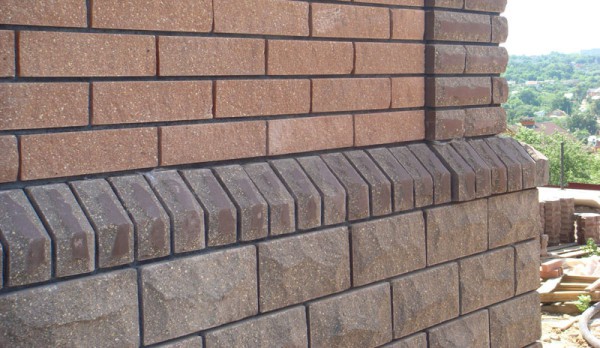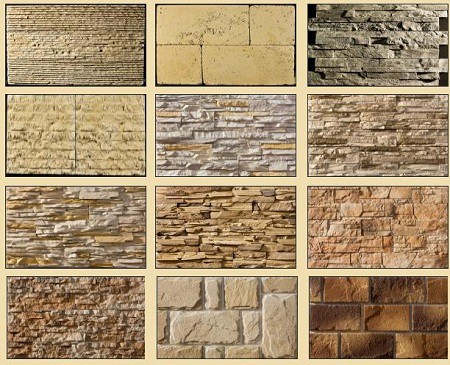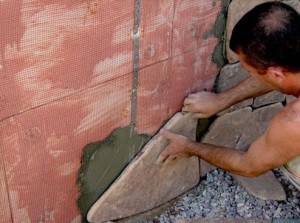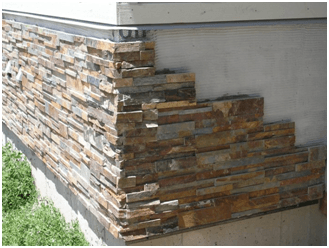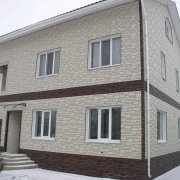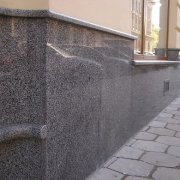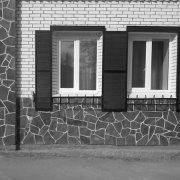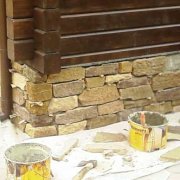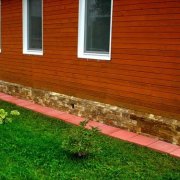Stone basement: what material is suitable
Facing the basement with stone has become the most common in construction. All this is due to the fact that the stone has excellent technical properties, and they do not depend on what kind of origin it is.
The content of the article
What types of stones are used to clad a building
Facing the basement and facade with a stone is most often performed using:
- Natural agglomerate.
- Artificial stone.
These materials are almost similar in their properties and characteristics. The only thing that differs them is the price, it is several times higher for natural stone than for decorative material.
Characteristics of natural and artificial stones
Facing the socles with stone has the characteristics of the materials that are used in it.
If these are stones, then she:
- Very strong and reliable. The surface of such a finish is able to withstand almost any load.
Quite often, decorative forged metal elements are used on stone trim. It can be flashlights and more. - Practical, as it does not require special care due to the fact that it is not able to absorb various contaminants.
- Moisture resistant. It does not react with deformation to wet weather conditions and freely perceives a direct hit of liquid on the surface.
- It does not burn and does not melt, since natural stone freely tolerates the effects of a direct source of fire, and the surface of the decorative stone is reliably protected by a special tool.
- It is frost-resistant, because in its structure and natural origin, natural stone is not able to respond to low temperature conditions, and decorative stone is made from raw materials, which, after passing a lengthy treatment, can perceive low temperatures.
- It has an attractive appearance and a wide variety of sizes.
Facing socle stone, both natural and artificial, has a long service life. It is at least 20 years old.
Throughout the entire period of use of the material, it does not lose its appearance and properties, which makes it wear-resistant.
Types of natural stones that are used for cladding
Facing with natural stone basement can be performed:
- With marble.
- Granite (seeFacing with granite base: classic facade design).
- Sandstone.
- Shell rock and so on.
Natural stones for facing the basement can have such surfaces:
- Smooth.
- Polished.
- Sawn.
- Pound.
Benefits:
- These types of surfaces are made using special equipment.
- Natural sinter has high strength and durability.
- Its installation can be quite simple to do with your own hands and not involve specialists in this field.
Natural stone for facing the base has different sizes and shapes.
He can be:
- Square shape.
- Rectangular shape.
- Rounded shape.
- Non-standard options are also found.
The thickness of the stone in this case can be 0.5 cm or 1 cm. Manufacturers do not make a large thickness, since then facing the stone with the basement of the house can have a huge mass and over time, the finish can peel off the surface.
Note.Also, such a thickness allows the lining of the base to be done with its own hands.
How can I make the lining of the basement natural stone
How to clad the base with natural stone?
Everything is very simple. The complexity of the work depends on the size of the material and the means used for its installation.
Tip. It is worth considering that natural stone has too much mass and in order to perform its installation on any surface it is necessary to strengthen it.
So:
- The stone for the plinth is mounted only on a flat surface. Its alignment occurs simultaneously with amplification.
- In order to strengthen the surface, a special wire mesh is used. The thickness of the cells in this case depends on the size of the stone itself. The larger they are, the larger should be the mesh cells.
- It is fixed to the surface using special rivets or when applying concrete mortar.
Tip. The easiest way to fix on the surface of the grid is the use of metal burdock, which are screwed.
- Surface leveling is carried out using plaster or concrete mortar. It is worth considering that if you use the latter method, then you need to apply the product very carefully, since there will be no way to use sandpaper after it is dried to eliminate defects.
To prepare a concrete solution, you must use:
- Cement.
- Sand.
- Water.
Performance of work:
- The proportions of this composition can be different, since it all depends on the required strength of the solution.
Tip. The more mass the stone has for facing the socle, the stronger the concrete solution should be. In it, cement occupies a large part and you need to use a certain brand - 400.
- As for the application for leveling the surface of the plaster, it is necessary that it be moisture resistant, as it is used for outdoor applications.
Two types of such a tool are needed:
- "Start".
- "The finish".
Tip. Since the lining of the base with natural stone, although it requires a flat surface, it will not be necessary to use finishing plaster. Its main properties will be the elimination of defects in the starting layer, and they will be covered by the finish.
How to clad the base stone of natural origin?
Everything is very simple and for work you will need:
- A solution of concrete, which will be similar in composition to a solution of the same product, only for leveling the surface.
- The construction level, since without it it will not be possible to evenly expose and mount each finishing element.
- Tile cutter or other equipment for cutting sizes of natural sinter.
- Spatula for applying mortar to the inner surface of the stone.
So:
- Facing socles natural stone runs from bottom to top. That is, initially at the bottom of the structure in the corners it is laid out with a stone and only after it is firmly fixed to the surface can it be further mounted.
- Facing stones for a basement of natural origin are considered quite cold material and in order to protect completely from the cold the whole structure needs to be insulated.
Tip. Alignment of the surface occurs along with insulation. This will save time on finishing.
Thin sheets are used for this:
- Styrofoam.
- Styrofoam.
- Extruded Polyurethane Foam.
- In rare cases, mineral wool is used, since over time it begins to lose its properties and characteristics. It, unlike previous heaters, is not an insulating material.
Note.
Due to the fact that the insulation sheets have a certain strength, then they need to be mounted on the surface using special fasteners. After that, OSB or drywall sheets are already superimposed on them, which are subjected to finishing with plaster or concrete mortar.
Upon completion of such work, a natural facing stone for the basement of the house.
Artificial stone for use in plinth decoration
The decorative facing stone for the base is used due to the fact that in appearance and design it does not differ from the natural agglomerate.
Its properties are also similar. Only its strength is several times lower than natural stone.
It can have the following surface types:
- Smooth.
- Structural.
- Embossed.
- Torn.
So:
- The most commonly used fragmentary stone for facing the basement. It has an unusual shape and appearance.
- Due to this, the finish looks very original.
- There are imitations of marble, shell rock, granite, sandstone and other natural agglomerates.
That is, the basement facing with an artificial stone takes various forms and designs.
Installation of artificial stone on the surface of the base
How to clad the base with artificial stone?
All installation work of such decorative material is carried out similarly to fixing natural stone on the surface of the basement. Also, it will be necessary to carry out surface leveling and insulation.
Stages of work:
- The same materials and tools are used for this. Only when installing artificial stone will it not be necessary to strengthen the surface, since it has a small mass.
- The stone can be mounted on any surface and if during the insulation process the insulating material is covered with drywall, OSB or plywood, then you can mount it directly on their surface.
Tip. It must be primed with a special tool - a primer to ensure a good bond between the mounting solution and the surface itself.
For the installation of artificial stone, concrete mortar or special glue for ceramic tiles is used. Also, each element is set initially in level and only then fixed to the surface. The video shows this installation process.
Lay a decorative stone in two ways. All elements can be located close to each other or separately.
